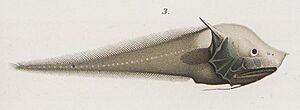Bony-eared assfish facts for kids
The bony-eared assfish (Acanthonus armatus) is a fascinating deep-sea fish. It lives in the very deep parts of warm oceans, from about 1,171 to 4,415 meters (3,842 to 14,485 feet) below the surface. You can find it in many places, even as far north as Queen Charlotte Sound near British Columbia, Canada. This fish can grow up to 37.5 centimeters (about 15 inches) long. When they are young (larvae), they look a bit like a related fish called the gargoyle cusk. However, young bony-eared assfish have longer rays on their pectoral fins.
Quick facts for kids Bony-eared assfishTemporal range: Holocene
|
|
|---|---|
 |
|
| Specimen from north of New Guinea | |
 |
|
| Specimen from south of Panama | |
| Conservation status | |
| Scientific classification | |
| Synonyms | |
|
Contents
Unique Features of the Assfish
The bony-eared assfish is quite special. It might have the smallest brain compared to its body size of any animal with a backbone.
How it Survives in the Deep Sea
Like many other animals that live deep in the ocean, the assfish has a soft, floppy body. It also has a very light skeleton. This is probably because there isn't much food in the deep sea. Also, the water pressure is extremely high. These conditions make it hard for the fish to grow strong muscles and bones.
What's in a Name?
The scientific name for the bony-eared assfish is Acanthonus armatus. Let's break down how it got this interesting name!
The First Discovery
The very first bony-eared assfish studied was about 11.5 inches (29 centimeters) long. It was caught during a famous trip called the Challenger expedition, which explored the oceans from 1872 to 1876. This fish was found north of New Guinea, about 1,075 fathoms (1,966 meters or 6,450 feet) deep.
Who Named It?
A German fish expert named Albert Günther described this fish in 1878. He gave it its scientific name.
Meaning of the Name
The word Armatus comes from Latin and means "armed." This part of the name likely refers to the small spines that the fish has near its nose and gills. These spines might also be why it's called "bony-eared."
The first part of the scientific name, Acanthonus, comes from Ancient Greek. Akanthos means "prickly." The second part, onus, could mean "hake," which is a type of fish related to cod. However, it could also mean "donkey" or "ass." So, the name points to a prickly fish that might remind someone of a donkey!


